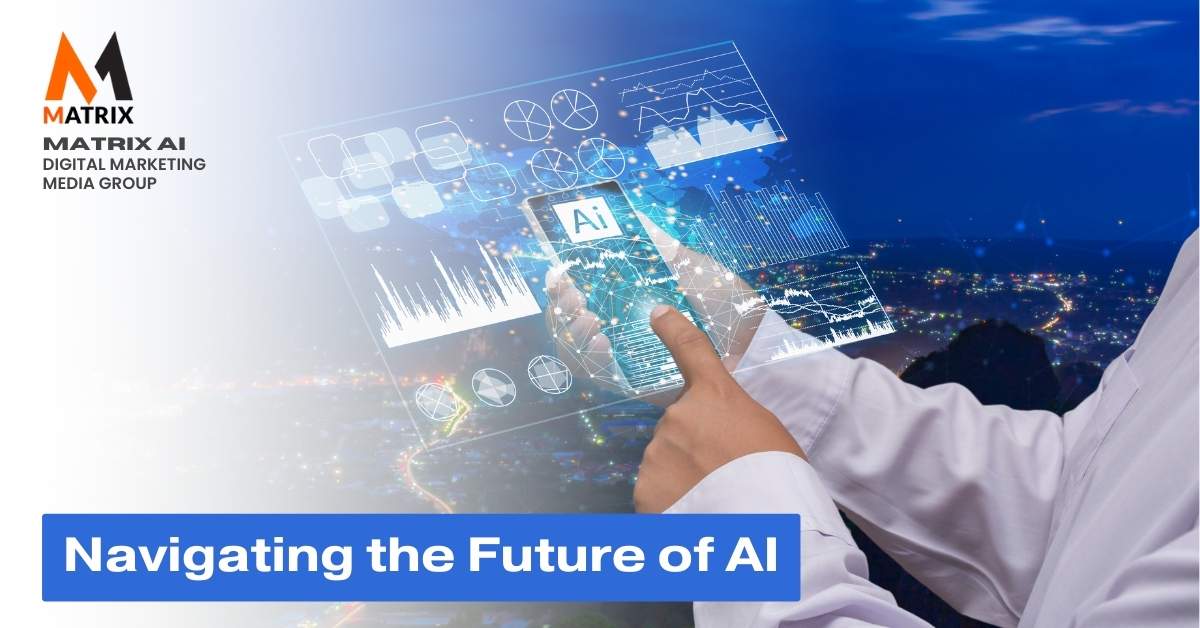Navigating the Future of AI: Building Trust in Transformative Technologies
Story: Emily’s AI Revelation
Emily sat in her corner office, staring at the city skyline out the window. As the Chief Marketing Officer for a mid-sized software company, she had always been skeptical about the growing buzz around AI content generation.
To her, the idea of machines replacing human creativity felt impersonal, even risky. “How could AI possibly understand the nuance of our brand?” she often thought.
Her marketing strategy had always been built around human connection—her team’s deep understanding of the industry, personal insights into customer needs, and creative storytelling that resonated with their audience.
One afternoon, during a meeting with her CEO, an unsettling topic came up. “Emily, I’ve been hearing about what some of our competitors are doing with AI content. They’re churning out more content faster and cheaper than us, making a difference in their market share.” The CEO’s words lingered in her mind. Emily had heard the rumors—competitors pushing out blogs, whitepapers, and ad campaigns seemingly overnight. But she dismissed it, thinking that quality would always outshine quantity.
Still, something gnawed at her. She decided to do some research and found MatrixLabX.
Over the next few days, Emily studied what the competition was up to. She looked at their content output, engagement rates, and how often their brand was mentioned online. The numbers were staggering. Competitors released twice as much content as her team, and engagement grew exponentially. Her company’s organic traffic, on the other hand, was stagnating. Slowly, the realization dawned on her—AI was not just a trend; it was the future. And she was behind.
Reluctantly, she decided to explore AI content generation. Emily contacted a few agencies specializing in AI-driven content, and Matrix’s AIContentPad subscription model stood out as the best.
One of them introduced her to an AI tool that didn’t just churn out words—it could analyze market trends, predict customer preferences, and create tailored content that aligned with her company’s brand voice. It wasn’t just about speed or cost; the AI had data-driven insights that could sharpen her strategy.
Emily decided to test the waters. She started with something small—a series of blog posts about the latest trends in her industry. What happened next surprised her. The AI-generated content matched the tone and quality her team was known for and freed up their time for more strategic initiatives.
Her writers no longer spent hours researching and drafting content from scratch. Instead, they focused on refining and optimizing the AI’s output, adding their human touch to elevate it further. What is an AI Content Assessment?
Within weeks, her company’s content pipeline grew dramatically. She was able to produce whitepapers, videos, product descriptions, and social media posts at a pace she never thought possible. Engagement rates began to climb, and her company started outranking competitors in search engine results.
The CEO, impressed by the turnaround, asked her what had changed. “We embraced AI,” Emily admitted with a smile, though some of her still felt amazement at the transformation.
But Emily soon realized the most significant impact wasn’t just the increase in content volume. It was how AI allowed her team to shift focus from routine tasks to innovation.
They had more time to develop creative campaigns, experiment with new ideas, and interact with customers more meaningfully. The human element wasn’t lost—it was enhanced. The AI became a powerful ally, not a replacement.
By the end of the quarter, her marketing department was a model of efficiency and creativity. What had once seemed like a threat—AI content generation—had become the secret weapon that propelled her company ahead of the competition. Emily, the once-skeptical marketer, had evolved into a forward-thinking leader, guiding her team through the cutting edge of digital marketing.
The lesson was clear: AI wasn’t just about doing more; it was about doing better.
As Emily stood before her team during a strategy meeting, she no longer doubted AI’s place in her marketing operation. “We’re not losing our creativity,” she said. “We’re empowering it. And with the right tools, we’ll be unbeatable.”
Her team smiled in agreement. The future was bright, and Emily was ready to lead them.
Unlocking AI’s Potential: A CEO’s Perspective

A striking statistic stands out as CEOs navigate the rapidly evolving landscape of artificial intelligence (AI). Companies that effectively implement AI see a 40% increase in operational efficiency within the first year. This compelling figure underscores AI’s transformative potential, yet it also brings to light a critical question: How can CEOs ensure their journey into AI is beneficial and trustworthy?
Addressing the Elephant in the Room: Trust and Transparency
Integrating AI into business operations often raises significant concerns among executives, ranging from data security to ethical considerations. Addressing these concerns upfront is essential.
Transparency in AI implementation involves being clear about AI systems’ capabilities and limitations and ensuring that ethical guidelines and data privacy standards are rigorously maintained.
By fostering an environment of open communication and adhering to robust ethical frameworks, CEOs can build a foundation of trust that supports the successful adoption of AI technologies. AI Product Management: Why Software Product Managers Need to Understand AI and Machine Learning
Evidence-Based Recommendations for AI Success
To effectively navigate the future of AI, CEOs should prioritize evidence-based strategies. Research indicates that companies that adopt a phased approach to AI implementation, starting with pilot projects and gradually scaling up, are more likely to achieve sustained success.
Furthermore, investing in continuous employee training and fostering a culture of innovation can significantly enhance the workforce’s adaptability and resilience, ensuring that the organization remains at the forefront of AI advancements.
By addressing potential concerns transparently and leveraging evidence-based recommendations, CEOs can confidently steer their organizations through the complexities of AI, unlocking unprecedented opportunities for growth and efficiency.
Navigating the Future of AI: Why CEOs Must Lead the Charge

Understanding the Core of AI’s Evolving Landscape
Navigating AI’s future involves understanding its transformative potential and strategic implementation within an organization. At its essence, artificial intelligence is revolutionizing industries by augmenting decision-making, optimizing operations, and generating innovative solutions. AI Marketing Plan for Manufacturing Businesses
The rapid evolution of AI technologies presents unprecedented opportunities and complex challenges. For a CEO, leading the endeavor to integrate AI is about staying competitive and envisioning and crafting the company’s future path.
Why CEOs Are Central to AI Adoption
CEOs must spearhead the AI journey because they are uniquely positioned to align AI initiatives with the organization’s strategic vision.
By fostering a culture of innovation and investment in AI, they can guide their businesses through ethical considerations, workforce transitions, and market dynamics.
The CEOs can forge critical partnerships, advocate for AI literacy across all levels, and ensure the organization’s adaptation to AI is holistic and sustainable.
Where AI Will Transform Business Landscapes
AI is poised to redefine value chains and customer experiences from finance to healthcare, retail to manufacturing. CEOs who proactively engage with AI can identify new revenue streams, enhance operational efficiencies, and improve customer engagement through personalized experiences.
Staying ahead means embracing AI and navigating potential pitfalls such as data privacy, cybersecurity, and societal impact.
As stewards of AI innovation, CEOs will drive forward the responsible and impactful deployment of AI technologies in their respective domains.
Engage with the future of AI now—because the journey begins at the top.
Does your organization need help keeping up with rapid AI advancements?

The Problem: Increasing Complexity and Cost of AI Integration
In the fast-paced world of artificial intelligence, the responsibilities of CEOs have become significantly daunting.
The rapid advancement of AI technologies is leading to increased complexities and escalating costs for proper integration.
As today’s competitive landscape demands quick and efficient implementation of AI to drive business growth, many executives need more time to handle the high expenses involved and the necessity for continuous learning and adaptation.
Falling Behind Competitors and Losing Market Share
Imagine your competitors leveraging AI to improve customer experiences, drive efficiency, and predict market trends while your organization lags and is unable to keep up.
The stress of potentially losing market share can be overwhelming. Struggling with outdated systems and high integration costs hampers innovation and diminishes your company’s reputation and growth potential.
Such a scenario creates a sense of urgency—pushing your company further away from leadership in your industry.
Revolutionize Your Business with Our AI Marketing Solutions
Our cutting-edge AI marketing solutions are designed to tackle these challenges head-on. We offer an array of streamlined, cost-effective AI tools that seamlessly integrate with your current systems, reducing complexity and driving efficiency.
With our solutions, you can make insightful data-driven decisions, automate customer interactions, and personalize marketing strategies without spending a fortune.
Embrace the future of AI with confidence and ease, ensuring that your organization not only keeps up with competitors but leads the way.
Ready to Transform Your Business?
Don’t let the complexities and costs of AI integration hinder your progress.
Contact us today to discover how our innovative solutions can propel your business to new heights and ensure you stay ahead in the competitive AI-driven landscape. How to Use AI Digital Marketing to Transform Your Marketing Results
Expert Testimonials on Navigating the Future of AI and Leadership

The Visionary Perspective
“Artificial Intelligence is not just a tool, it’s a paradigm shift,” says Dr. Angela Roberts, a leading AI researcher at the Institute of Future Technologies. “CEOs who understand this are positioning their companies for exponential growth. They are not just focusing on automating tasks but are leveraging AI to innovate their entire business model.” Her insight underlines the importance of strategic vision in leveraging AI, suggesting that the future success of businesses hinges on their leaders’ ability to foresee and integrate AI advancements.
The Pragmatic Approach
John Thompson, CEO of TechSolutions Inc., emphasizes a balanced approach: “AI is transforming industries, but aligning AI initiatives with the core business strategy is critical. CEOs must prioritize AI investments that offer the highest return and integrate seamlessly with existing operations.” Thompson’s experience highlights the necessity of pragmatic decision-making and strategic planning in successfully adopting and executing AI projects.
The Ethical Consideration
“AI presents incredible opportunities but also significant ethical challenges,” remarks Dr. Maya Leonard, AI ethics lawyer and Stanford University professor.
“CEOs must lead with integrity, ensuring that their AI implementations are transparent, fair, and respect user privacy. The sustainable future of AI depends on how we address these ethical concerns today.”
Dr. Leonard’s perspective enriches the dialogue by emphasizing the ethical dimension, urging CEOs to consider the broader societal impact of their AI strategies.
Navigating the future of AI is multifaceted, requiring visionary insight, strategic pragmatism, and a keen sense of ethical responsibility.
Each expert opinion offers a unique angle on how leaders can successfully steer their companies through the AI revolution, ensuring growth and innovation, ethical integrity, and societal well-being.
Navigating the Future of AI: Best Practices and Success Stories
As artificial intelligence (AI) continues to evolve rapidly, harnessing its potential is crucial for businesses that want to stay ahead.
Adopting best practices in AI implementation drives innovation and promotes sustainable growth. Here, we’ll explore strategies that less-known but pioneering brands have successfully employed.
Embracing Ethical AI: LuminaHealth
LuminaHealth, a startup specializing in AI-driven health diagnostics, prioritizes ethical AI. By implementing stringent guidelines and transparency measures, LuminaHealth ensures patient data is used responsibly.
Their algorithms are designed to be unbiased, providing equitable healthcare solutions. This commitment to ethical AI has garnered trust and positioned them as leaders in ethical medical technology.
Leveraging AI for Customization: TrendSync
Customization is key in today’s competitive market. TrendSync, an emerging e-commerce platform, uses AI to personalize customer experiences meticulously. By analyzing user behavior, purchase history, and social media interactions, TrendSync’s AI tools tailor product recommendations to individual preferences. This targeted approach enhances user satisfaction and drives repeat business and customer loyalty.
Innovation through AI Collaboration: AgriTec
Collaboration in AI can lead to groundbreaking innovations. AgriTec, a relatively unknown agricultural technology firm, collaborates with AI research institutions to innovate in precision farming. Their AI systems analyze vast datasets from satellite imagery, weather patterns, and soil conditions to optimize crop yields while minimizing resource usage. This collaborative approach has resulted in sustainable farming practices reshaping the agriculture industry.
These examples from LuminaHealth, TrendSync, and AgriTec underscore the importance of ethical considerations, customization, and collaboration in AI development. As these brands navigate the future of AI, their success stories highlight actionable strategies for other businesses aiming to harness AI’s transformative potential.
By learning from these trailblazers, companies can spark curiosity and engage stakeholders in their AI journeys.
Embarking on the Journey with Matrix: Navigating the Future of AI

Understanding the Matrix Paradigm
Imagine stepping into a realm where reality is intertwined with infinite possibilities.
The Matrix isn’t just a concept from a science fiction story—it’s a powerful framework for exploring artificial intelligence in unprecedented ways.
This virtual landscape allows us to construct, manipulate, and observe AI behaviors within a controlled, dynamic environment. By immersing ourselves in the Matrix, we can unlock new potentials and understand AI from a multi-dimensional perspective. Are you ready to dive in?
Getting Started: The First Steps
To embark on this journey, one must first grasp the fundamentals of the Matrix as a simulation tool. Begin by familiarizing yourself with basic programming and AI concepts.
With its extensive libraries like TensorFlow and PyTorch, Python is an excellent starting point. Next, delve into virtual environments and simulators.
Platforms like Unity and Unreal Engine offer robust frameworks to build and visualize your AI-driven worlds.
Creating a virtual city where AI agents navigate, learn, and interact just like in the real world. This step-by-step approach not only builds your technical skills but also sparks creativity.
Crafting Your AI Matrix: A Practical Guide
Once you’ve gained a foundational understanding, it’s time to craft your own AI Matrix. Start small by designing simple environments. For instance, construct a basic simulation where AI agents navigate a maze.
Gradually introduce complexities—add obstacles, integrate decision-making processes, and enhance sensory inputs. Use reinforcement learning to train your agents, rewarding them for successful navigation and penalizing missteps.
As your agents become more adept, scale up the environment’s complexity and introduce collaboration or competition among multiple agents.
Imagining Future Scenarios
Finally, let your imagination soar. With a firm grasp of matrix-based AI simulations, you’re poised to tackle futuristic scenarios.
Think about smart cities where AI optimizes traffic flow, or virtual ecosystems where digital wildlife evolves. By pushing the boundaries of the Matrix, you not only propel your understanding of AI but also contribute to the broader discourse on its future applications.
Each simulation and algorithm is a step towards a future where AI seamlessly integrates into our lives, making it more efficient, knowledgeable, and surprisingly human.
Navigating the Future of AI: A Glimpse into Tomorrow’s Innovations
The Unstoppable Rise of Artificial Intelligence
Artificial Intelligence (AI) is not just a technological advancement; it’s a seismic shift transforming every facet of our lives.
AI’s footprint is ubiquitous, from personal assistants like Siri and Alexa to complex algorithms driving financial markets.
The future promises even more profound changes as AI integrates deeper into healthcare, education, and beyond.
Ethical Considerations and Responsible AI
With great power comes great responsibility.
As AI continues to evolve, ethical concerns surrounding its application are at the forefront. Privacy, data security, and bias in AI algorithms warrant robust discussions and proactive measures.
Ensuring that AI develops balanced and fairly is crucial for maintaining public trust and maximizing societal benefits.
Innovations on the Horizon
The next wave of AI innovations promises to push boundaries further. Quantum computing, for instance, might exponentially boost AI’s capabilities, solving problems that are currently insurmountable.
Autonomous vehicles, advanced diagnostics in medicine, and AI-driven personalized learning environments are just the peaks of this innovation iceberg.
Embracing Change and Preparing for the Future
As we navigate the AI-driven future, individuals and organizations must stay informed and adaptable.
Investing in education and training to develop AI-related skills will empower the workforce.
Moreover, fostering a culture of continuous learning and curiosity will ensure that society can harness AI’s potential while mitigating its risks.
Learn more about Matrix Marketing Group at Matrix Marketing Group at marketinggroup.com and MatrixLabX at matrixlabix.com


